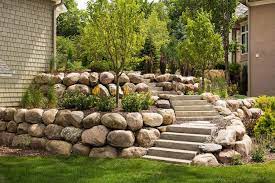Sandstone retaining walls are not only functional structures but also add a touch of aesthetic appeal to landscapes. With their unique textures and hues, they blend seamlessly into natural surroundings, enhancing the overall beauty of outdoor spaces.
However, beyond their visual allure, the durability of sandstone retaining walls is a crucial aspect to consider. In this article, we delve into the structural beauty of sandstone retaining walls and explore their durability under various conditions.
Understanding Sandstone
Sandstone is a sedimentary rock composed of sand-sized mineral particles, primarily quartz, feldspar, and other minerals.
Its formation involves the consolidation and compaction of sand over millions of years, resulting in a rock with distinct layers and patterns.
Sandstone is renowned for its durability, making it a popular choice for various construction purposes, including retaining walls.
The Construction Process
Building a sandstone retaining wall requires meticulous planning and execution by sandstone retaining wall installer to ensure its structural integrity and longevity. The process typically involves the following steps:
Site Preparation: Clearing the area and ensuring proper drainage to prevent water buildup behind the wall.
Foundation: Excavating a trench and compacting the soil to create a stable base for the wall.
Placement of Sandstone Blocks: Selecting and arranging sandstone blocks in a manner that provides stability and aesthetic appeal.
Backfilling: Filling the space behind the wall with gravel or crushed stone to enhance drainage.
Finishing Touches: Securing the top layer of the wall with coping stones and adding landscaping elements to complement the design.
Several factors influence the durability of sandstone retaining walls:
Material Quality: The quality of the sandstone blocks used in construction significantly impacts the wall’s durability. High-quality sandstone with proper density and hardness is more resistant to weathering and erosion.
Climate and Environmental Conditions: Exposure to extreme weather conditions, such as freeze-thaw cycles, heavy rainfall, and prolonged sunlight, can affect the durability of sandstone retaining walls. Proper sealing and maintenance are essential to protect the wall from environmental damage.
Foundation Stability: A stable foundation is crucial for the longevity of a retaining wall. Proper compaction of the soil and adequate drainage prevent settlement and structural failure over time.
Design and Construction Techniques: The design and construction techniques employed play a vital role in enhancing the durability of sandstone retaining walls. Proper reinforcement, use of appropriate mortar or adhesive, and attention to detail during installation contribute to the structural integrity of the wall.
Maintenance: Regular inspection and maintenance are essential to ensure the continued durability of sandstone retaining walls. This includes cleaning the surface, repairing any cracks or damage, and resealing the wall as needed.
Advantages of Sandstone Retaining Walls
Sandstone retaining walls offer several advantages, including:
Natural Aesthetic: The unique textures and colors of sandstone enhance the visual appeal of outdoor spaces, blending seamlessly with natural surroundings.
Durability: When properly constructed and maintained, sandstone retaining walls are highly durable and can withstand the test of time.
Versatility: Sandstone blocks come in various shapes and sizes, allowing for versatile design options to suit different landscape styles and preferences.
Environmentally Friendly: Sandstone is a natural, eco-friendly material that harmonizes with the environment and contributes to sustainable landscaping practices.
Increased Property Value: Well-designed sandstone retaining walls not only improve the functionality of outdoor spaces but also add value to residential and commercial properties.
Conclusion
Sandstone retaining walls are not only functional structures but also architectural elements that enhance the beauty of outdoor landscapes. Their durability, when properly constructed and maintained, makes them a reliable choice for retaining soil, preventing erosion, and defining outdoor spaces.
By understanding the factors that influence their durability and employing proper construction techniques, sandstone retaining walls can stand the test of time while adding a touch of structural beauty to any environment.



